Key points
Improved establishment of grower-retained open-pollinated canola seed relies on:
- matching the sowing time to the variety type;
- targeting a high density of plants;
- ensuring adequate phosphorus fertiliser is applied;
- allowing the canola seed crop to mature naturally; and
- grading the canola so only large seeds are planted.
Now is the time to consider which part of your open-pollinated canola crop will be earmarked for next year’s seed.
Colin McMaster, a research agronomist at the NSW Department of Primary Industries (DPI), says the effective establishment of open-pollinated canola varieties involves more than planting large-sized seeds.
“Large-sized seed is important but does not guarantee a high percentage of plant establishment, especially if your seed crop was poorly managed,” Mr McMaster says.
“Plan to scout paddocks during September to check which canola crops were planted at the right time on your best soils at the highest density with sufficient phosphorus and freedom from disease.
“Other characteristics to look for are plants that flowered at the right time and were not affected by frost or heat, as these are just some of the factors that can combine to compromise next year’s canola establishment."
Seed performance
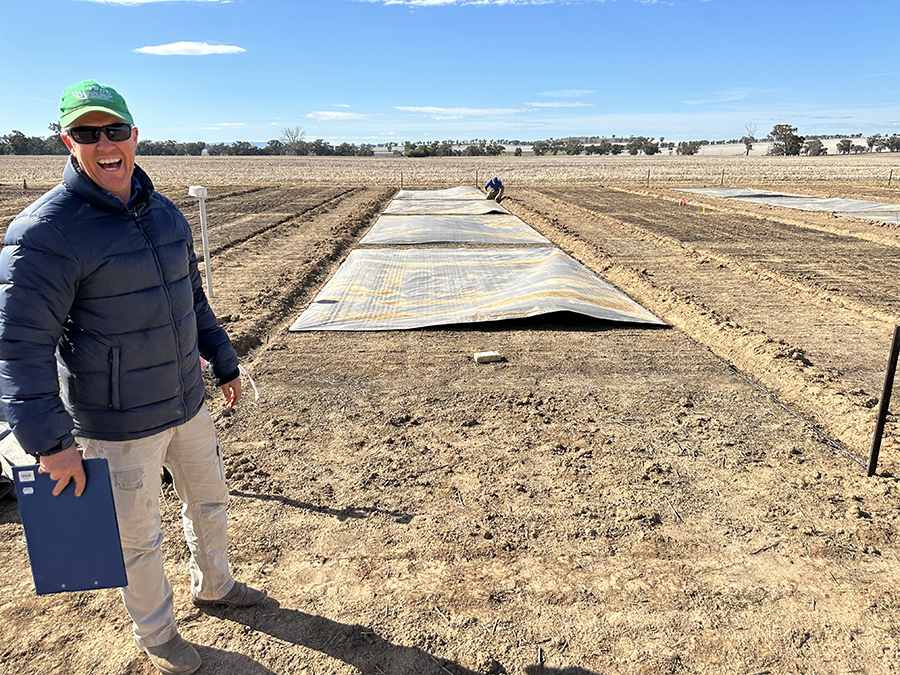
NSW Department of Primary Industries research officer Colin McMaster (left) and his team cover canola establishment plots to ensure intermittent rain does not disrupt CSIRO and NSW DPI studies, with GRDC investment, on temperature and moisture in central NSW. Photo: John Kirkegaard
During the past two years, Mr McMaster – with co-investment from GRDC and the NSW DPI – explored how the management of this year’s open-pollinated canola affects the performance of next year’s seed.
With input from Ag Grow Agronomy & Research and Grain Orana Alliance, he says the research built on earlier work that showed only 48 per cent of canola seed sown grew into plants.
“Previous research showed that when we lowered the stubble load, we improved establishment by 10 per cent, and when we reduced our sowing speed, establishment lifted by 16 per cent,” he says.
“Separating the fertiliser from the seed increased establishment by seven per cent, while a consistent seeding depth lifted establishment by 17 per cent.
“We also saw up to a seven per cent increase in canola establishment by sowing hybrid seed compared with the seed of open-pollinated varieties.”
While large seed was generally associated with improved establishment, he says some large-sized seeds also established poorly. This suggested that there were other factors affecting the percentage of seeds that grow into plants.
“Seed size alone does not guarantee high seedling vigour if the seed crop has been poorly managed for seed production.”
1. Match sowing date and phenology
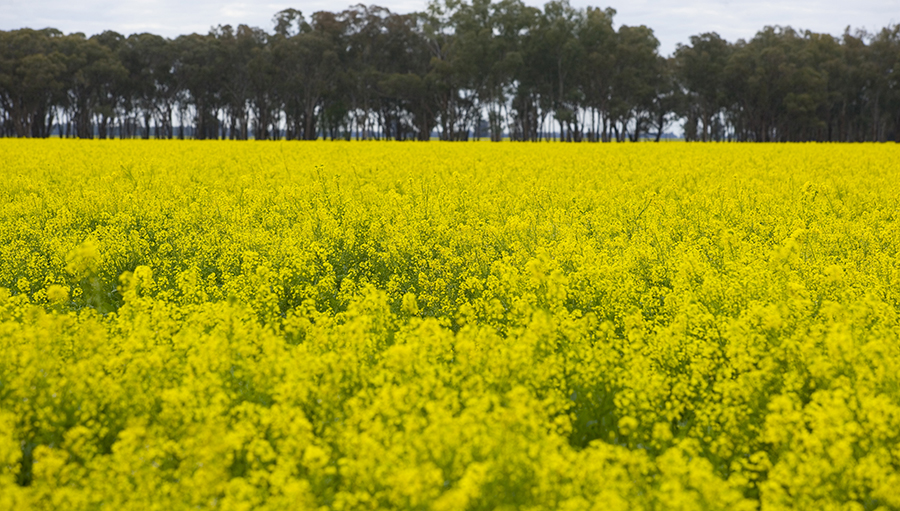
Aim to select planting seed from an open-pollinated canola crop planted to flower at the start of its optimal window for your location. Photo: Paul Jones
A canola variety’s phenology – such as ‘fast’, ‘mid’, ‘slow’ and ‘winter’ – describes how quickly the plant will move through the vegetative phase into the reproductive phase.
“When selecting next year’s seed from this year’s canola, ensure the seed is harvested from a crop sown in the right window.
“Be aware of the optimal flowering period for your location and always sow to ensure the variety planted flowers within that window.
“The benefit of having a canola crop flowering in the right window for your location is that you’ll reduce the risk of frost and heat stress.”
CSIRO has developed a Canola Flowering Calculator to check the optimal flowering period according to location. However, the calculator does not include the latest varieties.
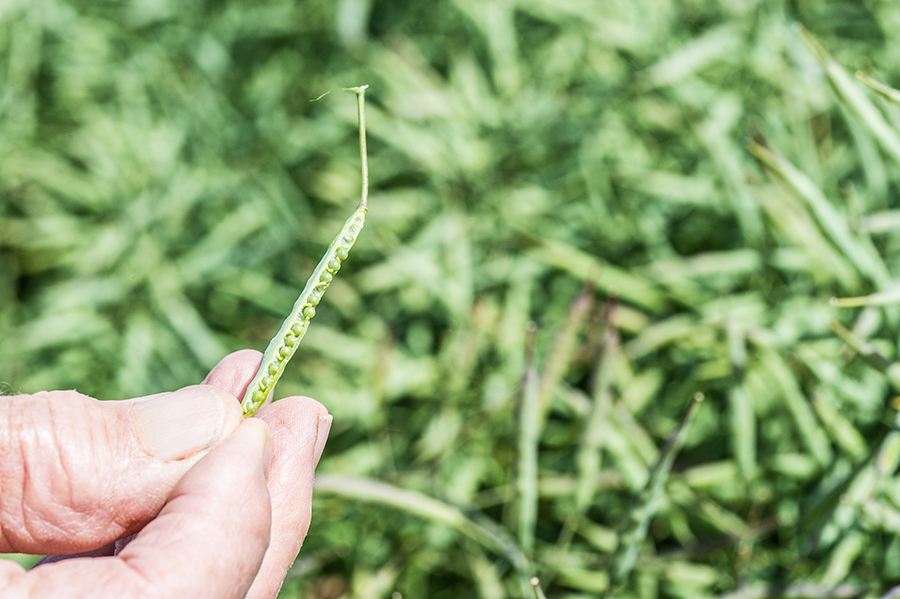
Chlorophyll levels are generally higher earlier in the life of most canola seeds. Photo: Nicole Baxter
Most winter crop sowing guides indicate the optimal sowing window, which is focused on matching the flowering period with the most favourable growing conditions for particular varieties.
Timely sowing, Mr McMaster says, also increases seed weight. The higher the seed weight, the higher the seedling weight.
“If a canola seed crop flowers during high temperatures, the seed coat tends to be thinner, which increases the risk of physical damage and the leaching of nutrients from within the seed.
Chlorophyll is at its highest when a seed is formed, he says, with enzyme activity degrading as a plant reaches maturity.
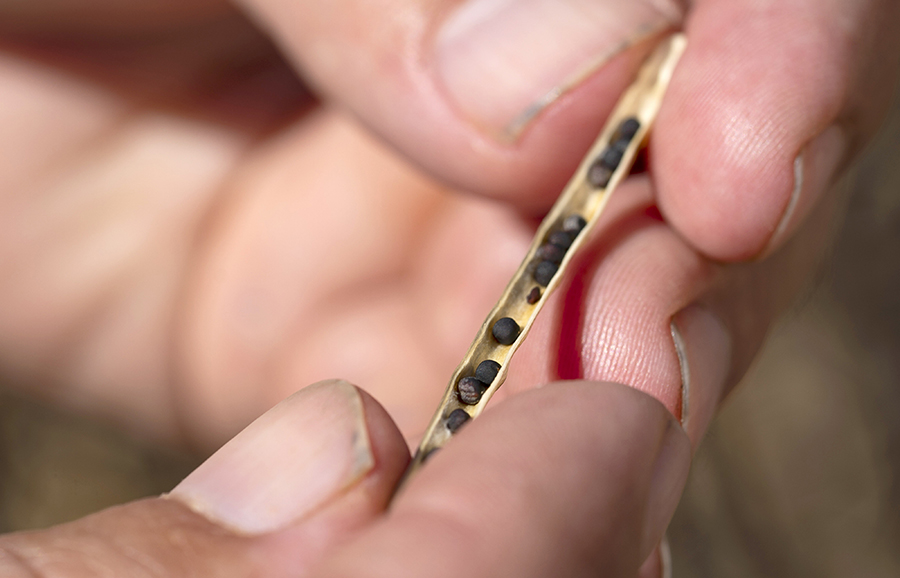
Chlorophyll levels are generally lower later in the life of most canola seeds, especially if seed crops are allowed to dry naturally and remain free from stress such as frost and heat. Photo: Evan Collis
“However, frost, heat, and rapid seed drying can all disrupt the enzyme activity within the seed needed to break down the chlorophyll.
“When seed dries rapidly, chlorophyll is trapped in the seed, which reduces seedling vigour and emergence.
“Seeds high in chlorophyll also tend to accumulate less seedling biomass than normal seeds.
“Therefore, take care when selecting a canola variety and sow to ensure the crop flowers at the start of its optimal flowering window to minimise stress events such as frost and heat.”
2. High plant density
Another way that crop establishment can be improved is by targeting a high plant density.
“There’s more inter-plant variation in seed maturity if the seed is taken from a crop planted at a low density – for example, six plants per square metre – compared with the seed planted at a high density such as 40 plants per square metre.
“When the seed is planted at 45 plants/m2, a less-bulky plant results, and most of the seed is produced on the main stem.” (Figure 1).
Figure 1: Target high plant density.
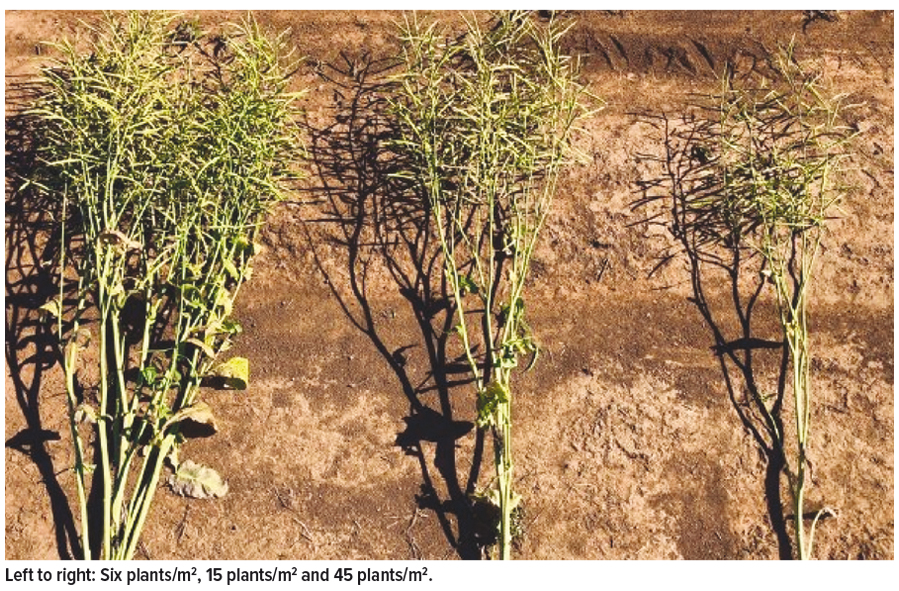
Source: Colin McMaster, NSW DPI
“At six plants/m2, branching occurs on the lower stem, which can be problematic because you might see 60 per cent seed colour change on the main stem, whereas the seed from lower branches may be only at 20 per cent colour change or less.
“The problem with branching is that the pods on the lower branches will have less time to fill, and they are also likely to be filling in hotter temperatures, which will increase the seed chlorophyll levels.
“Generally, canola seed from the main stem weighs more than seed grown on the lower branches.
“The main stem also has a competitive advantage over the lower branches because it has a slower and preferential accumulation of resources than the lower branches.
“Therefore, aim for a density of 30 to 40 plants/m2.”
He says other agronomic factors to help achieve a high plant density include:
- sowing into a reduced stubble load;
- reducing the sowing speed (a previous grower survey suggests six to eight kilometres per hour is ideal);
- ensuring seed and fertiliser are kept separate; and
- placing seed accurately and consistently.
“Something else to check is how many seeds you are sowing.
“Adjusting your sowing rate according to seed size is important.
“If you are unaware of your seed size, you might not be planting enough seeds, which will lower plant density.”
3. Apply adequate phosphorus
Another of Mr McMaster’s findings was that phosphorus-deficient canola seed crops produced up to 50 per cent abnormal seedlings.
“The seeds would germinate, but the seedlings grew abnormally and reduced crop establishment the following year.
“If you are growing a seed crop on low-phosphorus soils, keep your phosphorus rates high.” (Table 1).
Table 1: Canola establishment percentage according to NSW Department of Primary Industries trials.
| Seed size | Nil phosphorus per hectare | 12kg/ha of phosphorus | 20kg/ha of phosphorus |
|---|---|---|---|
| 1.6 to 1.8mm | 42 per cent | 56 per cent | 59 per cent |
| 1.8 to 2.0mm | 53 per cent | 59 per cent | 64 per cent |
| 2.0 to 2.2mm | 63 per cent | 70 per cent | 72 per cent |
Source: Colin McMaster, NSW DPI
Figure 2: The phosphorus rate of the seed crop affects the following year’s seed germination.
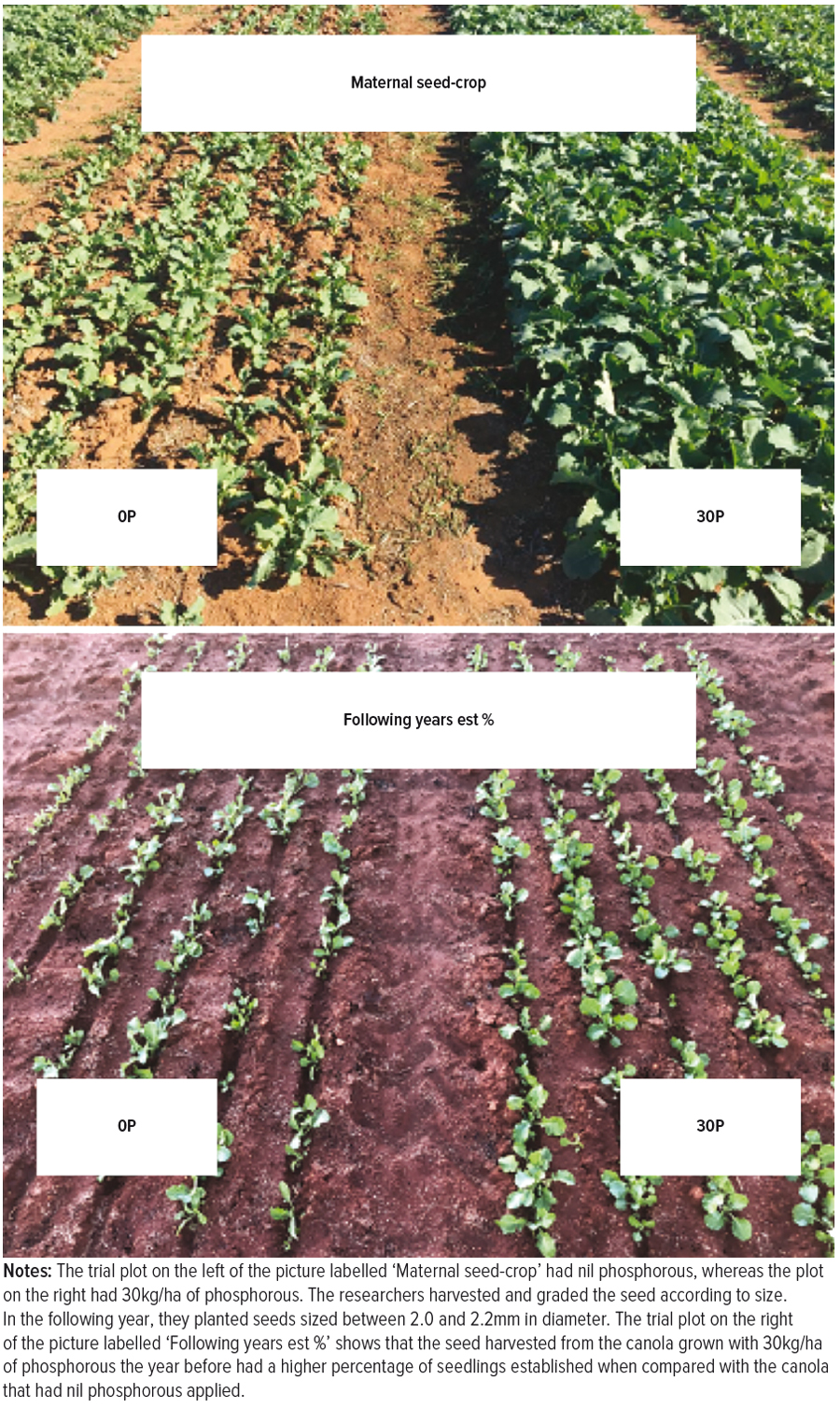
Notes: The trial plot on the left of the picture labelled ‘Maternal seed-crop’ had nil phosphorus, whereas the plot on the right had 30kg/ha of phosphorus. The researchers harvested and graded the seed according to size. In the following year, they planted seeds sized between 2.0 and 2.2mm in diameter. The trial plot on the right of the picture labelled ‘Following years est %’ shows that the seed harvested from the canola grown with 30kg/ha of phosphorus the year before had a higher percentage of seedlings established when compared with the canola that had nil phosphorus applied.
Source: Colin McMaster, NSW DPI
One of the disadvantages of keeping phosphorus rates high is that excessively high rates can also reduce establishment.
“Accordingly, it’s important to know your seedbed utilisation*, which is the amount of the seedbed over which the fertiliser has been spread expressed as a percentage relative to row space,” he says.
“We evaluated different monoammonium phosphate (MAP) rates relative to different seed sizes with the hypothesis that a bigger seed might be less susceptible to burning.
“However, when canola was sown into moist soil, we found that as the MAP rate increased, establishment decreased regardless of seed size (Figure 3a).
“In marginal moisture conditions, sowing canola with a disc seeder that provided a seedbed utilisation of six to seven per cent reduced establishment from 90 per cent at nil MAP to less than 50 per cent with 150kg/ha of MAP (Figure 3b).
Figure 3: Monoammonium phosphate fertiliser toxicity (a) in moist soil (2022) and (b) marginal moisture (2021).
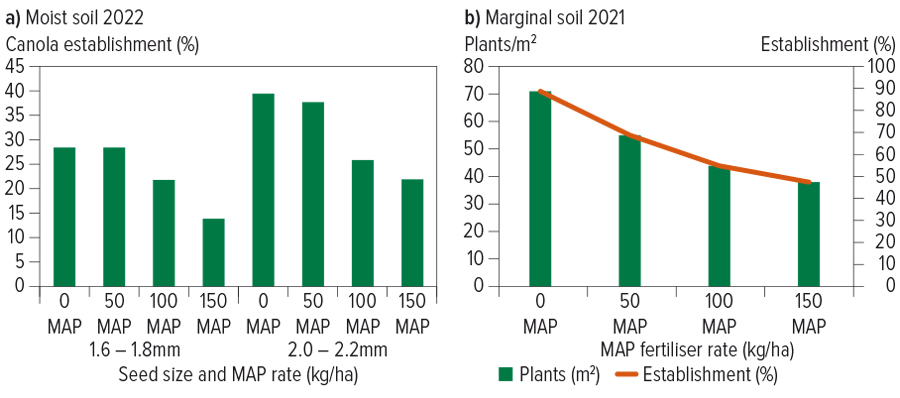
Source: Colin McMaster, NSW DPI
“About 50kg/ha of MAP applied with the seed is relatively safe, but the risk of damage increases in marginal moisture conditions.
“Increase your sowing rate by 10 to 20 per cent if your seed cannot be separated from your fertiliser.”
4. Harvest management
Allowing canola seed crops to mature naturally enables the enzymes within the seed to clear out the chlorophyll.
“Desiccation narrows the window for the enzymes within the seed to dissipate the chlorophyll because of rapid seed moisture drying.
“I strongly advise you not to use glyphosate as a harvest aid or late weed control on your seed crops because it can have a major negative effect on seed establishment (Figure 4).
Figure 4: The effects of glyphosate, windrowing and direct heading on canola establishment.
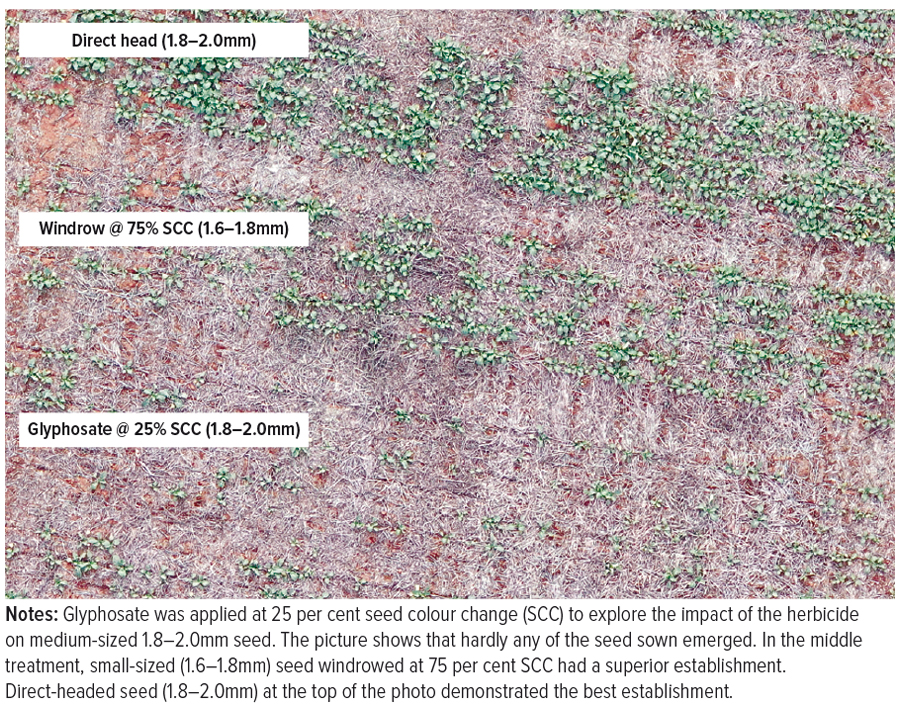
Notes: Glyphosate was applied at 25 per cent seed colour change (SCC) to explore the impact of the herbicide on medium-sized 1.8 to 2.0mm seed. The picture shows that hardly any of the seed sown emerged. In the middle treatment, small-sized (1.6 to 1.8mm) seed windrowed at 75 per cent SCC had a superior establishment. Direct-headed seed (1.8 to 2.0mm) at the top of the photo demonstrated the best establishment.
Source: Colin McMaster, NSW DPI
“Direct heading is the preferred harvest option, but if direct heading is not possible because of logistics, windrow the crop in the cool of the evening at 75 to 80 per cent seed colour change (SCC).
“Windrowing in the cool of the evening slows seed moisture drying and helps enzymes within the seeds to clear out the seed chlorophyll.”
5. Grade seed for size
The last step is to retain large-sized seeds by grading. “The bigger the seed, the better. Larger seeds are required when sowing depth increases (Figure 5).
“This is because a larger seed size will always provide quicker ground cover no matter the sowing depth.”
Figure 5: Grade to remove small seeds.
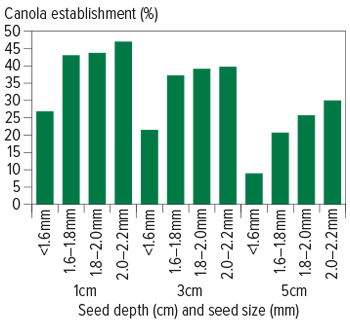
Notes: Grade seed to 1.8mm and above as a minimum. If you can grade seed to 2.0 to 2.2mm, the establishment is likely to be improved, but generally, only 2 to 3 per cent of seed might only be that large. This means you must put a lot of seed through the grader to extract enough large seed for sowing.
Source: Colin McMaster, NSW DPI
At a minimum, Mr McMaster says to ensure that seed smaller than 1.6mm in diameter is removed by grading.
“Very small seeds tend to have a higher percentage of abnormal seedlings, poor seed coat integrity and reduced hypocotyl length.”
Lastly, he says, if you plan to buy grower-retained open-pollinated canola seed, buy it from areas likely to have experienced a cooler or ‘softer’ finish.
More information: Colin McMaster, 0427 940 847, colin.mcmaster@dpi.nsw.gov.au

























































